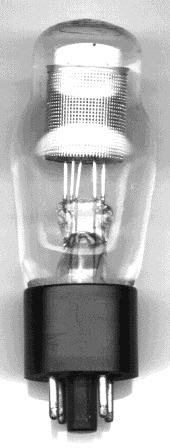The Amazing Crosley Autoexpressionator
Starting about 1935, many top-of-the-line radios and radio/phonographs included various types of volume expanders. Some employed several extra tubes, while others used ordinary tungsten filament light bulbs or a special tube containing two tungsten filaments within a shield.
Crosley, among others, used pilot lamps similar to the current type 47s as well as the special tube noted above and referred to as the "Phantom Conductor" or "Auto Expressionator". For example, the Crosley model 955 used lamp bulbs, but the model 816 and the 37 tube "WLW Special" employed the special tube type, Crosley part number W-41187, containing two tungsten filaments within a shield that was grounded to the radio chassis. Crosley's description from Rider's Volume 7 is as follows:
 "The Phantom Conductor tube, illustration #49, is connected across the voice coil of the speaker. When operating, its resistance varies so as to increase the volume of loud notes, thus giving a wider volume range to reproduce music, which tends to compensate for electrical limitations of broadcasting equipment."
"The Phantom Conductor tube, illustration #49, is connected across the voice coil of the speaker. When operating, its resistance varies so as to increase the volume of loud notes, thus giving a wider volume range to reproduce music, which tends to compensate for electrical limitations of broadcasting equipment."
So, one can imagine that there is a phantom orchestra conductor inside the amazing Auto Expressionator tube gesticulating "fortissimo" and "pianissimo", while its filaments glow and fade, glow and fade.......
On the other hand, tungsten filaments have a large positive temperature coefficient. That is, their resistance increases by a factor of about ten as applied voltage increases, and that increases the volume of the loud tones and reduces the volume of the weaker tones, hence "expansion".
However, costs are exacted by this form of volume expansion. To begin with, there is some net loss of audio power to the speaker, for, no matter how hot it gets, the filament still loads the voice coil somewhat. Additionally, the filament has a substantial thermal mass, and that slows its build-up and fall-off of resistance. This is likely to be annoying to the ear when listening to percussion instruments or going rapidly either way from fortissimo and pianissimo. But, think of the money Crosley saved compared to the cost of a better expander, such as the one in the RCA model D-22.
